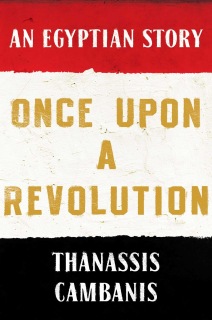 |
| Once Upon A Revolution |
Thanassis Cambanis’ Once Upon A Revolution is a bottom-up approach in narrating the most important part of the Arab Spring. While Danahar’s was more of a top-down approach, covering things from an impersonal angle. Cambanis brings up-front and up-close with revolutionaries who actually participated in the uprisings in Tahrir Square and are still hopeful of contributing more towards working on their defeats (not ‘failures’ as Cambanis mentions) towards a better Egypt. The book isn’t written with the flair of Robert Fisk or even Mark Bowden, but is highly accessible without engaging in detailed historical descriptions of Egypt. The last point however also serves as a weakness for any reader who may not be aware of Egypt’s modern history. But, well, one book can’t be everything to everyone.
His focus is on two revolutionaries, Moaz Abdelkarim (a pharmacist and activist who grew up in the Muslim Brotherhood and not afraid of taking political stands) and Basem Kamel (an architect who avoided politics till he turned forty) and gives personal details of their lives before the revolution and their background, which actually made them ready for playing a part in it. He writes, “Egypt was on the verge of revolution, as it has been for as long as modern history had been recorded, but the revolution never came. There were occasional mirages such as 1952, when the Free Officers expelled Egypt’s foreign masters but then enslaved it under and indigenous military dictatorship”. Basem got involved with a Facebook group created by Abdelrahman Yousef, who was a well-known intellectual and criticized Muslim Brotherhood. The passing of baton from King Farouk to Nasser to Sadat to Mubarak is covered in, as mentioned earlie, brief passages which serve their purpose – not to get mired in complex history of the Middle East and lose focus. Both Moaz and Basem had parents who traveled to Saudi Arabia for better economic prospects. The death of Khaled Said at the hands of police brutality in Alexandria set off in motion the rise of unprecedented protests, finally culminating in the Mubarak’s loss of power, and Mohamed Morsi, with Brotherhood background, becoming the President. Muslim Brotherhood was considered opportunistic by many because they joined the protestors only when it seemed plausible to overthrow Mubarak, who had been anti-Brotherhood since an assassination attempt on him during a State visit to Addis Ababa in Ethiopia in 1995. The group, Gamaa, were political descendants of Sadat’s killers.
Morsi later found himself at the receiving end of the protests because of his Brotherhood leanings, ultimately being caught by soldiers and Abdel Fattah el-Sisi taking over the charge. He had a military background and was Field Marshal just before becoming President (probably got himself appointed as Field Marshal just before retirement – “as vain as he was ambitious”, Cambanis writes).
In conclusion, he assesses the revolution and why it failed to achieve what it set out for in the beginning – “it wasn’t organized, it wasn’t political, and, most fatally, it didn’t have a compelling, constructive idea at its center”; “never developed any alternative or supplement to street protests”; and the “guiltiest party on this front was the Muslim Brotherhood”. He quotes a figure of $12 billion spent by Saudi Arabia and other Gulf countries in bringing el-Sisi to power.
A good book to get an insider’s view of how the revolution was brought about, and why it got defeated at the hands of “secretive elites and military” who engaged in private deals that “left little opportunity for a revolutionary agenda”.
